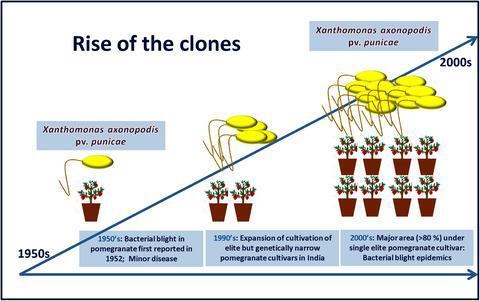当前位置:
X-MOL 学术
›
Plant Pathol.
›
论文详情
Our official English website, www.x-mol.net, welcomes your feedback! (Note: you will need to create a separate account there.)
Polyphasic phenotypic and genetic analysis reveals clonal nature of Xanthomonas axonopodis pv. punicae causing pomegranate bacterial blight
Plant Pathology ( IF 2.7 ) Pub Date : 2019-12-16 , DOI: 10.1111/ppa.13128 A. Kumar 1 , J. Sharma 2 , V. Munjal 1 , K. Sakthivel 3 , S. K. Thalor 1 , K. K. Mondal 1 , S. Chinchure 2 , R. Gharate 2
Plant Pathology ( IF 2.7 ) Pub Date : 2019-12-16 , DOI: 10.1111/ppa.13128 A. Kumar 1 , J. Sharma 2 , V. Munjal 1 , K. Sakthivel 3 , S. K. Thalor 1 , K. K. Mondal 1 , S. Chinchure 2 , R. Gharate 2
Affiliation

|
Yellow‐pigmented bacteria isolated from blight‐affected pomegranate leaves and fruit across seven Indian states in epidemics during the years 2008–2016 were characterized and identified using phenotypic and genotypic tools. All bacterial isolates shared phenotypic traits such as colony morphology, NaCl and pH sensitivity and fuscan production, and caused typical lesions on pomegranate plants upon artificial inoculation. Analysis of 16S ribosomal DNA and 16S–23S rDNA intergenic spacer sequences confirmed their identity as Xanthomonas axonopodis pv. punicae. The new isolates collected after 2000 were compared with an old isolate from the 1950s using polyphasic taxonomic approaches including multilocus sequence analysis (MLSA). Nucleotide polymorphism in 24 isolates for nine genomic loci (dnaK, fyuA, gyrB (Young), gyrB (Almeida), rpoD, fusA, gapA, gltA and lepA) showed minor variations in loci fyuA and gyrB. Isolates were grouped into four nearly identical sequence types, ST1, ST2, ST3 and ST4, based on their allelic profiles, ST3 being widespread in Indian states. Molecular phylogenetic analysis of concatenated 5690 bp with other Xanthomonas pathovars revealed its close genetic similarity with the X. citri group. The blight outbreak in diverse geographical locations is attributed to a re‐emerged clonal population of X. axonopodis pv. punicae on a genetically homogenous pomegranate cultivar. The latently infected vegetative planting material of elite pomegranate cultivars contributed to the dissemination of the bacterial inoculum. This study highlights and forewarns of the role played by the clonally propagated elite pomegranate cultivars in disseminating and sustaining clonal populations of this bacterial plant pathogen in many Indian states.
中文翻译:

多相表型和遗传分析揭示了Xanthomonas axonopodis pv的克隆性质。石榴引起石榴枯萎病
使用表型和基因型工具对流行病在2008年至2016年间从印度七个州的受疫病影响的石榴叶和果实中分离出的黄色色素细菌进行了表征和鉴定。所有细菌分离物都具有表型性状,例如菌落形态,NaCl和pH敏感性以及岩藻纤维蛋白产量,并且在人工接种后对石榴植物造成典型损害。对16S核糖体DNA和16S–23S rDNA基因间隔序列的分析证实了它们与Xanthomonas axonopodis pv的身份相同。pun科。使用多相分类学方法(包括多基因座序列分析(MLSA)),将2000年后收集的新分离株与1950年代的旧分离株进行了比较。在9个基因组位点(dnaK,fyuA,gyrB(年轻),gyrB(阿尔梅达),rpoD,fusA,gapA,gltA和lepA)的24个分离物中的核苷酸多态性显示,位点fyuA和gyrB的变异很小。根据等位基因特征,将分离物分为四个几乎相同的序列类型:ST1,ST2,ST3和ST4,ST3在印度各州广泛分布。级联5690个碱基与其他的分子系统发育分析黄pathovars发现与它密切遗传相似柑橘黄单胞集团。在不同地理位置的疫病暴发归因于轴突X.axonopodis pv的克隆种群的重新出现。pun科在遗传上同质的石榴品种上。优良石榴品种的潜在感染植物营养种植材料有助于细菌接种物的传播。这项研究突出并预示了在印度许多邦,无性繁殖的优良石榴品种在传播和维持这种细菌植物病原体的克隆种群中所起的作用。
更新日期:2019-12-16
中文翻译:

多相表型和遗传分析揭示了Xanthomonas axonopodis pv的克隆性质。石榴引起石榴枯萎病
使用表型和基因型工具对流行病在2008年至2016年间从印度七个州的受疫病影响的石榴叶和果实中分离出的黄色色素细菌进行了表征和鉴定。所有细菌分离物都具有表型性状,例如菌落形态,NaCl和pH敏感性以及岩藻纤维蛋白产量,并且在人工接种后对石榴植物造成典型损害。对16S核糖体DNA和16S–23S rDNA基因间隔序列的分析证实了它们与Xanthomonas axonopodis pv的身份相同。pun科。使用多相分类学方法(包括多基因座序列分析(MLSA)),将2000年后收集的新分离株与1950年代的旧分离株进行了比较。在9个基因组位点(dnaK,fyuA,gyrB(年轻),gyrB(阿尔梅达),rpoD,fusA,gapA,gltA和lepA)的24个分离物中的核苷酸多态性显示,位点fyuA和gyrB的变异很小。根据等位基因特征,将分离物分为四个几乎相同的序列类型:ST1,ST2,ST3和ST4,ST3在印度各州广泛分布。级联5690个碱基与其他的分子系统发育分析黄pathovars发现与它密切遗传相似柑橘黄单胞集团。在不同地理位置的疫病暴发归因于轴突X.axonopodis pv的克隆种群的重新出现。pun科在遗传上同质的石榴品种上。优良石榴品种的潜在感染植物营养种植材料有助于细菌接种物的传播。这项研究突出并预示了在印度许多邦,无性繁殖的优良石榴品种在传播和维持这种细菌植物病原体的克隆种群中所起的作用。



























 京公网安备 11010802027423号
京公网安备 11010802027423号